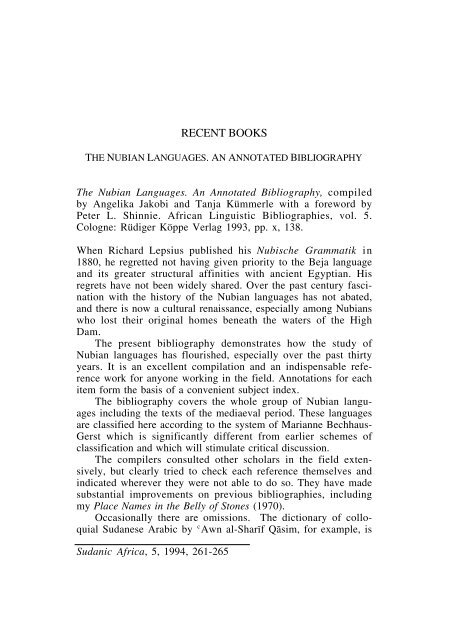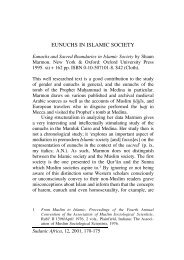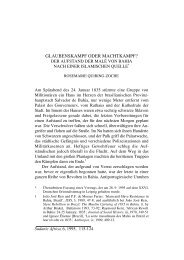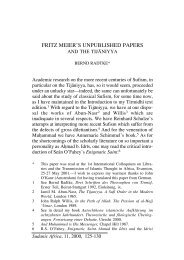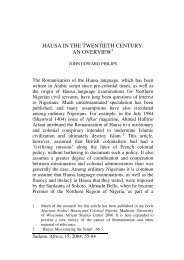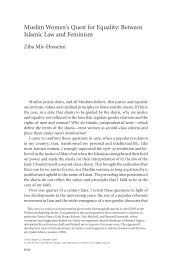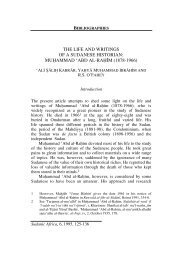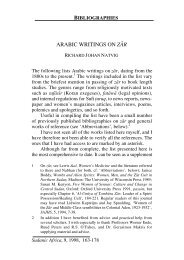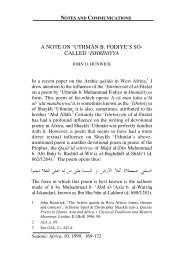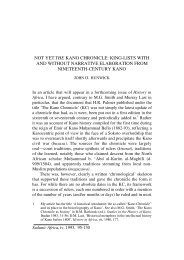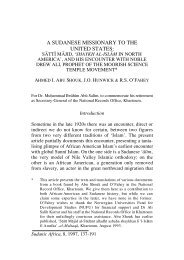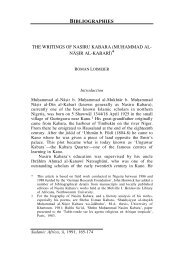The Nubian Languages. An Annotated Bibliography
The Nubian Languages. An Annotated Bibliography
The Nubian Languages. An Annotated Bibliography
Create successful ePaper yourself
Turn your PDF publications into a flip-book with our unique Google optimized e-Paper software.
RECENT BOOKSTHE NUBIAN LANGUAGES. AN ANNOTATED BIBLIOGRAPHY<strong>The</strong> <strong>Nubian</strong> <strong>Languages</strong>. <strong>An</strong> <strong>An</strong>notated <strong>Bibliography</strong>, compiledby <strong>An</strong>gelika Jakobi and Tanja Kµmmerle with a foreword byPeter L. Shinnie. African Linguistic Bibliographies, vol. 5.Cologne: Rµdiger Köppe Verlag 1993, pp. x, 138.When Richard Lepsius published his Nubische Grammatik in1880, he regretted not having given priority to the Beja languageand its greater structural affinities with ancient Egyptian. Hisregrets have not been widely shared. Over the past century fascinationwith the history of the <strong>Nubian</strong> languages has not abated,and there is now a cultural renaissance, especially among <strong>Nubian</strong>swho lost their original homes beneath the waters of the HighDam.<strong>The</strong> present bibliography demonstrates how the study of<strong>Nubian</strong> languages has flourished, especially over the past thirtyyears. It is an excellent compilation and an indispensable referencework for anyone working in the field. <strong>An</strong>notations for eachitem form the basis of a convenient subject index.<strong>The</strong> bibliography covers the whole group of <strong>Nubian</strong> languagesincluding the texts of the mediaeval period. <strong>The</strong>se languagesare classified here according to the system of Marianne Bechhaus-Gerst which is significantly different from earlier schemes ofclassification and which will stimulate critical discussion.<strong>The</strong> compilers consulted other scholars in the field extensively,but clearly tried to check each reference themselves andindicated wherever they were not able to do so. <strong>The</strong>y have madesubstantial improvements on previous bibliographies, includingmy Place Names in the Belly of Stones (1970).Occasionally there are omissions. <strong>The</strong> dictionary of colloquialSudanese Arabic by fiAwn al-Sharıf Qapplesim, for example, isSudanic Africa, 5, 1994, 261-265
262 NOTES AND COMMUNICATIONSfar more significant than his two articles which are cited in thebibliography. <strong>The</strong> dictionary gives extensive and precise detailson the debt of Sudanese Arabic to Nobíin and Dungulapplewı andalso provides representations of <strong>Nubian</strong> sounds in Arabic script,see his Qapplemüs al-la˛ja al-fiapplemmiyya fı ’l-Südapplen (2 edn, Cairo: al-Maktab al-Mißrı al-˛adıth 1405/1985, pp. 1251).<strong>The</strong> bibliography includes <strong>Nubian</strong> texts in translation such asA. and W. Kronenberg, Nubische Märchen (1978). <strong>The</strong>refore itshould also include Stories of Serra East by the late JamapplelMu˛ammad A˛mad (Khartoum: Khartoum University Press1985, pp. ix, 89). <strong>The</strong>se stories come from a place of some significance.Serra was the home of ˛applejj ˘asan who was theprincipal <strong>Nubian</strong> collaborator with Lepsius on the NubischeGrammatik (1880). <strong>The</strong> preface of that grammar acknowledgesthat it was ˛applejj ˘asan who originally translated the Gospel ofMark from Arabic into Nobíin; consequently he deserves mentionin the bibliography along with the entry I„n©gil Yesu…A major <strong>Nubian</strong> scholar of the early twentieth century wasSamuel fiAlı ˘ussain who translated the Gospels into Kanzı, butthe full range of his work cannot be appreciated withoutreference to his articles in the journal Der Sudan-Pionier,founded in 1900. Although the journal may be difficult to locate,the complete series is available at the Evangelische Mission inOberägypten, Walkmµhlstra˝e 8, 6200 Wiesbaden, Germany.<strong>The</strong>re should be a reference to it.A useful feature of the present bibliography is that it linkspublications with their relevant review articles. Reviews arenotoriously scattered in the literature. It is therefore possible tosuggest a number of addenda, for instance:Lepsius, Nubische Grammatik (1880): reviewed by Adolf Erman,Göttingische gelehrte <strong>An</strong>zeigen, Jahrgang 1880, ii, 33, 1043-56.Griffith, Christian Documents (1928): reviewed by EnnoLittmann, Zeitschrift fµr Kirchengeschichte, xlvii, 1928, 574-7; also reviewed by F.C. Burkitt, Journal of <strong>The</strong>ologicalStudies, xxxi, 1930, 209-11.Reinisch, Die sprachliche Stellung des Nuba (1911): reviewed by
RECENT BOOKS 263George William Murray, <strong>The</strong> Cairo Scientific Journal, v,1911, 131-2.<strong>The</strong> bibliography provides a convenient list of <strong>Nubian</strong> languagenames for identifying the multitude of terms and spellingsscattered through the literature. A note should be added to theeffect that the language name ‘Daier’ could be ambiguous. In onestudy it does not refer to Dair <strong>Nubian</strong>, but to another language ofthe Jabal Dair region (see P. Daniel Kauczor and Albert Drexel,‘Die Daiersprache in Kordofan’, Bibliotheca Africana, Innsbruck,iv, 1, 1930-31, 67-78 and iv, 2, 42-53). <strong>The</strong> non-<strong>Nubian</strong> ‘Daier’language of this study is known elsewhere in the literature asAfitti; Roland Stevenson preferred to call it Dinik as a result of hisfieldwork in the late 1970s. However, the study by Kauczor andDrexel is not exclusively devoted to Dinik. It also includes severalcomments on the <strong>Nubian</strong> language of Dair. It is arguabletherefore that this study should be cited in the bibliography. Itrecords impressions of the neighbouring <strong>Nubian</strong> dialects by aspeaker of Dinik (p. 67). <strong>The</strong>re is a brief tonal characterization ofDilling and Ghulfapplen <strong>Nubian</strong> (pp. 42-3). Furthermore, itchallenges Junker and Czermak for referring to the <strong>Nubian</strong>language of their Kordofân-Texte (1913) as Dair rather thanGhulfapplen (p. 68 note).<strong>The</strong> present bibliography ought to have included severalarticles from Sudan Notes and Records (SNR) which my PlaceNames had earlier listed as references for <strong>Nubian</strong> linguistics. Oneof these is an article which deals primarily with another language(Daju), but which has a list of 37 Hill <strong>Nubian</strong> words with variantsfrom an outlying area (‘Tabag, Abu ∏anuk, Kuπürıa’, seeS. Hillelson, ‘Notes on the Dago’, SNR, viii, 1925, 59-73).<strong>An</strong>other article describes a particular Hill <strong>Nubian</strong> area with dataon clans and their geographical position together with commentson language and some <strong>Nubian</strong> terminology (see S.F. Nadel,‘<strong>The</strong> Hill Tribes of Kadero’, SNR, xxv, 1942, 37-79). A thirdarticle deals primarily with the Afitti, but has numerousreferences to Hill <strong>Nubian</strong> terms (see P. Daniel Kauczor, ‘<strong>The</strong>Afitti Nuba of Gebel Dair and <strong>The</strong>ir Relation to the NubaProper’, SNR, vi, 1923, 1-34). Other articles, such as A.J.
264 NOTES AND COMMUNICATIONSArkell,‘<strong>The</strong> Baza Festival in Jebel Meidob’ (SNR, xxviii, 1947,127-34) are marginally relevant since they describe social eventswith only occasional reference to <strong>Nubian</strong> terminology.Several unpublished theses are cited in the bibliography, e.g.Mu˛ammad (Mohamed) Yüsuf Sıd A˛mad, ‘<strong>An</strong> <strong>An</strong>alysis of theNuba Mountain Language Survey’ (1979) and fiUshapplerı A˛madMa˛müd, ‘<strong>The</strong> Phonology of a Dying <strong>Nubian</strong> Language: Birgid’(1974). <strong>The</strong>re is considerable scope here for additions, e.g.˘amad Sulaiman Mu˛ammad, ‘A History of the NorthernKordofan Nüba in the Light of Linguistic Evidence’ (Unpublishedthesis, Diploma of African and Asian Studies, Institute ofAfrican and Asian Studies, University of Khartoum 1974, pp.39). In a search for relevant theses it would be advisable to giveparticular attention to the universities of Egypt and the Sudan.In 1979 Tindil Sakrapplen produced an excellent phonology ofthe Kwashi dialect of Dilling <strong>Nubian</strong>, but died before he submittedthe final version as his thesis for an M.A. in Sudanese andAfrican <strong>Languages</strong> at the Institute of African and Asian Studies inKhartoum. One of his chapters is in my possession; it meritspublication and inclusion in the next edition of the <strong>Nubian</strong> bibliography.Perhaps we shall also see the vocabularies of Debri,Kadaru and Ghulfapplen from the Nachla˝ of Roland Stevenson.A cooperative effort should be made to record and preservestudies which are published in places where they may be neglected.<strong>The</strong> following addenda may fall into that category:Zetterstéen, K.V., Review of Reinisch, Das persönliche Fµrerwort(1909), Le Monde Oriental [=MO], iv, fasc. 1, 1910: bothsides of back cover after p. 88.Leander, P., Review of Reinisch, Die sprachliche Stellung desNuba (1911), MO iv, fasc. 3, 1910: inner front cover after p.185 and inner back cover after p. 256 [intended to be boundat end of volume. Reinisch (1911) was available for review in1910, as Leander explained: ‘tatsächlich schon 1910 erschienen’.]Lang, Karl, ‘Barea und Nuba’, Folia Ethno-Glossica (Hamburg:Henschel & Mµller, Exportbuchhandlung und <strong>An</strong>tiquariat),ii, 2, April 1926, 21-6.
RECENT BOOKS 265A renewed search of the Russian sources might produce furtheraddenda, for example I. Katsnel’son, and F. Mendel’son, SkazkiNarodov Sudana (Moscow: Izdatel’stvo ‘KhudozhestvennayaLiteratura’ 1968, pp. 343) with translations of <strong>Nubian</strong> stories, seepp. 7-108.Both the dissertation (1951-52) and the publication (1968) of<strong>The</strong> Verbal System by fiAbd al-Ra˛mapplen Ayyüb are cited in thebibliography, but here an annotation might be provided to theeffect that the large number of typographical errors in the latter,especially in the representation of <strong>Nubian</strong> texts, can be correctedby reference to the former.<strong>The</strong> bibliography maintains a high standard of accuracy, butthe rare slip does occur, e.g. the title of Scharff (1928) should be‘Storchjagd in Nubien’ [not ‘Storchenjagd…’].A parallel bibliography of <strong>Nubian</strong> songs would be desirable.<strong>The</strong>re are numerous collections such as the Dungulapplewı songsrecorded by Artur Simon of Berlin, or the recordings by ˘amzaal-Dın, not to mention the vast repertoire of Mu˛ammad Wardı.Linguists would be particularly interested in a transcription andanalysis of the lyrics.In the future we may expect a greater number of publicationsin Arabic as <strong>Nubian</strong>s increasingly demonstrate an involvement inthe renaissance of their languages. It is recommended that therebe a network of correspondents contributing information fromtheir own areas of specialization, e.g. Egyptian or Sudanesesources in Arabic, and that the present work become the foundationfor an on-line bibliography.<strong>The</strong> present bibliography is a substantial contribution to thestudy of <strong>Nubian</strong> languages and has been compiled with industryand care. <strong>An</strong>gelika Jakobi and Tanja Kµmmerle have a majorachievement to their credit.Herman Bell


